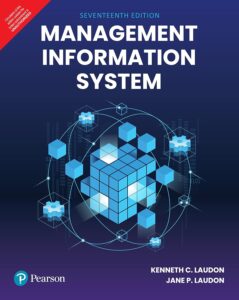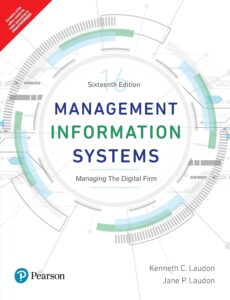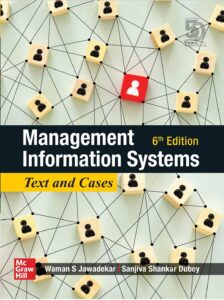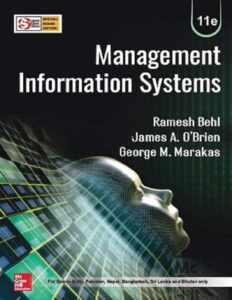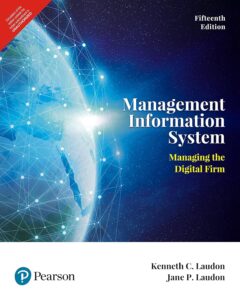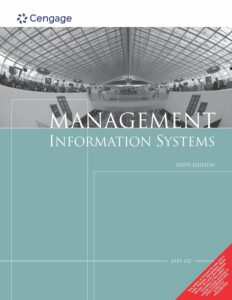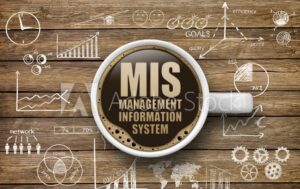
Table of Contents
Introduction
To handle any issue and exert effective control by making a timely decision. By carefully gathering, managing, and giving the appropriate information to the appropriate person at the appropriate time, the most accurate and trustworthy information is obtained through Management Information System (MIS).
A good management information system works as an efficient controlling approach in addition to lowering the risk of making bad judgments. Every level of manager needs critical information delivered quickly, succinctly, and economically to do their duties.
The management information system (MIS) is becoming increasingly significant as a result of the complexity of company and industrial activities. Government rules will also increase the need for timely, precise information that is more dependable. This demonstrates unequivocally that management leaders are moving into the “Information Age.”
Definition & Meaning
A management information system is a planned, organized, and systematic gathering of pertinent, precise, accurate, and timely information that is efficiently processed and delivered to the appropriate parties to attain organizational goals.
Management Information Systems are a formal method of collecting timely information in a presentable form in order to facilitate effective decisionmaking and implementation in order to carry out organisational operations for the purpose of achieving the organisational goals.
Walter J. Kennevan
“A formal method of making available to management accurate and timely information necessary to facilitate the decision-making process and enable the organization’s planning, control, and operational functions to be carried out effectively,” according to James A.F. Stoner, is how management information systems are defined.
“A management information system is a system intended to give Selected decision-oriented information required by management to plan and assess the operations of the organisation,” according to the Management Information System Committee of the Financial Executive Institute.
It is built on a foundation that emphasis profit planning, performance planning, and control at all levels. It considers the ultimate integration of the company’s necessary business information sub-systems, both financial and non-financial.
Information and Data
Data and information are not the same. Facts that are not presently being utilized for decision-making are referred to as data. Data may serve as a foundation for decision-making. Information, on the other hand, refers to processed data that is used directly throughout the decision-making process.
Simply said, information may be created from data. Similar to how data may be created from information. But neither data nor information can be used in place of the other.
The word “data” refers to information like the number of people employed, production and sales statistics, a variety of debtors and creditors, bonus information, and the like. This information may be processed, organised, and displayed so that choices about the organization’s planning and operational management can be made using it.
A suitable shape must be created from the provided data. Six functions are involved in data transformation. They are gathering data, handling it, analysing it, storing it, evaluating it, and providing it to those in need.
Since people will use the information to make choices, it may be managed carefully without losing any of its beneficial components. The reason is that with corporate expansion, a big volume of information may be handled everyday.
Daily computer printouts provide thousands of details about production schedules, current inventory positions of raw materials, goods in process, and finished products, output levels by plants, shifts, and departments; cost and sales analysis by territory, product, customer, sales division, and order size, etc.
Louis E. Boone
Key Components of MIS:
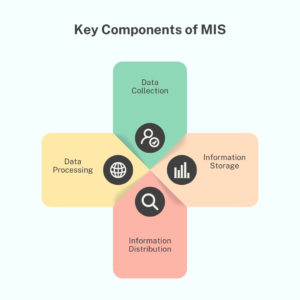
- Data Collection: Gathering data from internal and external sources.
- Data Processing: Converting raw data into useful information through analysis and interpretation.
- Information Storage: Keeping data and information accessible and secure for future use.
- Information Distribution: Delivering the right information to the right people at the right time to support decision-making.
Objectives of Management Information System
A successful management information system may accomplish the mentioned goals.
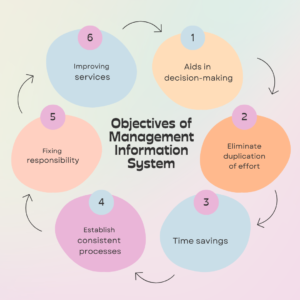
- Aids in decision-making: Management leaders at all levels make many choices based on the best available information at the time. Decisions are made much easier when information is accurate, trustworthy, clear, and timely.
- Eliminate duplication of effort: A large number of organisational functions are computerised, and the processes are made simpler. This kind of technology eliminates the performance of duplicate job and lowers unneeded effort.
- Time savings: Time-saving techniques are used to carry out given tasks, and workers of an organisation have access to the right guidance. Each work’s standard time is established independently. There is a chance of time savings in this approach.
- Establish consistent processes: Although the nature of the job varies from department to department and from section to section, standard and uniform procedures are followed when a task is performed. The appropriate flow of data from the respective department or unit is ensured by uniform processes.
- Fixing responsibility: Data must be provided right once when work is completed. As a result, the responsible executive must supply the information. MIS establishes each executive’s responsibilities in this manner.
- Improving services: Before establishing a management information system, executives must get the necessary training. As a result, executives in an organisation provide better service.
In order to accomplish the above mentioned goals, the management information system should be adaptable enough to integrate changes and include other sub-systems.
Check here for latest case studies and research book : https://kit.co/Anurooba/case-analysis-text-books
Elements of Management Information System
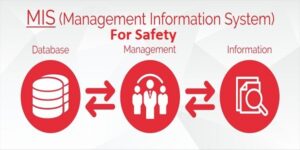
Three terms make up the phrase management information system. They are System, Information, and Management. One may fully comprehend the idea of a management information system if they are aware of the nature and meaning of these three terms.
Management
Planning, organising, and regulating both people and physical resources in order to accomplish an organization’s goals is the process of management. Managers may create a plan by deciding on the best course of action to accomplish the goals. He is able to recognise tasks that are organised into homogenous groupings that arise as a result of an organization’s operations.
By establishing performance criteria and preventing departures from those standards, the job completion process will be managed. In this setting, management enables the executives to make a variety of important choices on the planning, organising, and supervision of the execution of tasks and company processes.
Information
Information is a term used to describe concrete or intangible data used to lessen or eliminate ambiguity about events that will happen in the future. Every management needs information to successfully plan and manage the company operations.
From the facts that are already accessible, information is produced and utilised to aid in decision-making. The conversion of data into information must be done correctly. the act of presenting information in a manner that makes it relevant, useful, and simple to comprehend.
System
A system is a group of connected components that work together to accomplish the overall goals of an organisation.In an organisation, there may be several subsystems, and each of these subsystems is a component of larger systems. In a commercial organisation, it is necessary to use system principles.
If so, there is a chance that the sub-systems might be integrated via effective information exchange. By linking the working sub-systems via the interchange of information, the MIS system idea seeks to maximise the output of the organisation.
Powerpoint Presentation & PDF of MIS
Areas of Management Information System
The management information system is divided into three categories. They are control, planning, and decision-making. Below is a basic explanation of these regions.
Decision-making
MIS is intended to create and enable the free flow of data gathered from internal and external sources for good corporate decision-making across all functional areas. For quick and efficient decision-making, management should have a well-organized system for gathering information and maintaining current information.
At all management levels, MIS plays a significant role in the decision-making process.The basic goal of management information systems (MIS) is to assist managers in making timely decisions in their areas of accountability.
Planning
Information is needed by top management for planning purposes. The main duty of management is planning. Under a well-designed management information system, the managers effectively carry out the core role.
The MIS may sometimes be connected to other corporate planning frameworks. Through careful preparation, the ambiguity may be changed into a certainty. Only with the aid of a management information system is this feasible.
Control
The MIS provides information to the decision-maker about how the work is being performed in accordance with the standards that have been established. It is simpler for a manager to exert effective control if the information is better, more comprehensive, more trustworthy, and timely. To achieve adequate control, a system of controls must also be designed.
Importance of Management Information System
Due to the following factors, a management information system that is effective is crucial.
- Complexity of company operations: The environment’s dynamics will make business operations more difficult. In these circumstances, the MIS enables the managers to easily see the company processes.
- Business unit size: The majority of business units have expanded in size. As a consequence, management is taken away from the operational area. MIS is now essential to solving operational issues.
- Modifications to the economic structure: A business unit’s ability to operate effectively is impacted by changes in interest rates, the GNP, the rate of unemployment, and other factors. As a result, gathering this kind of data will aid managers in making wise choices.
- Technological changes: These include adjustments to how a business unit operates. Every time technology evolves, management encounters a challenge. Effective MIS may assist in solving this kind of issue with ease.
- Social changes: These include greater levels of education, shifting consumer preferences, home computer use, preferred occupations, etc. This kind of information is kept current. If so, managing a company division is quite simple.
- Determining the training requirements: Because operations in large-scale enterprises are decentralised, greater knowledge of unit operations is required. All units’ performance should be constantly monitored, and if there is poor performance, action must be done. It implies that training requirements may be determined in order to enhance unit performance. Here, MIS may be utilised efficiently to assess performance, determine the level of training required for improved performance, and realise organisational objectives and plans.
- Widespread usage of computers: Because they operate more cheaply and can store and provide more data, computers are extensively utilised. Handling information has become simpler as a result.
Factors Affecting the Management Information System
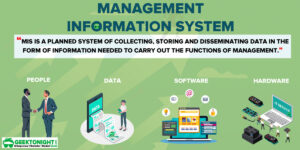
Within an organisation, information must freely flow from one location to another. If this is the case, then each employee tries to alter his behaviour by being aware of what is going on in the company. Despite the fact that certain variables limit the free flow of information Below is a list of them.
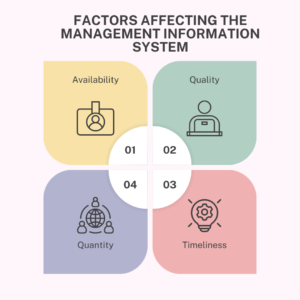
- Availability: Information that is readily available is usually more accurate and pertinent. All choices are based on the facts at hand. The outcomes are very unpredictable if judgments are made based on insufficient, incorrect, and irrelevant information. However, there is no criteria accessible to determine if the information is correct or not, relevant or not, and sufficient or not. As a result, the managers are compelled to make judgments based on the facts at hand.
- Quality: The precision and compactness of information are described by its quality. Sound judgments can only be made based on reliable information. As a result, the data must be accurate and very trustworthy.
- Quantity: It is difficult to get reliable information and too much information makes it difficult for management to digest it quickly and efficiently. On the other side, insufficient information may leave out relevant, trustworthy, and accurate information that is required to make wise judgments.
- Timeliness: Data must be accessible when required. Due to the lack of timely access to required information, certain significant choices may sometimes be postponed, leading to lost opportunities. In addition, as little time as feasible should elapse between the gathering of data and the presenting of the suggested information. In addition, information should be sent to the decision-maker just when necessary rather than on a regular and cyclical basis.
Types of information

- Operational details: These cover the numerous ways the unit operates. Operation information includes information on production and sales, the number of people employed, overtime work in terms of production and man hours, wastages in terms of unit of measurement, etc.
- State information: At a certain moment, the status of a particular project is provided. Examples of status information include work in progress in terms of unit of measurement, main project stage, stage of building work, etc.
- Resource data: It comprises an organization’s resources. Examples of resource information include own capital, borrowed capital, skilled human resources, semi-skilled human resources, unskilled human resources, materials, power, etc.
- Resource allocation information: This includes the distribution of available resources within an organisation, such as the employment of personnel according to department, the use of own capital for the purchase of fixed assets and current assets, the use of borrowed capital for the purchase of fixed assets and current assets, or the clearing of old debts.
- Planning and control information: Top management may plan and control for each activity. Examples of planning and control information include production and sales budgets, cash budget production schedules, capital budgeting, zero base budgeting, etc.
- Information on the government, including its budgetary policies: Every year, the government presents a budget that has an impact on business. Information on the magnitude and types of effects must be gathered and reported to the government.
- Social data: This includes demographic information. Social information includes data on the population in terms of urban and rural areas, sex, industrial workers, religion, and community.
- Economic data: It provides data about a country’s economic state. Economic data include the cost of living index, inflation rate, interest rate, per capita income, gross national product (GNP), and others.
- Information on technology: Each activity’s technology selection by the organisation is stored in a separate file. The information on technology also includes the newest technology available, the technology used by comparable units, and the gap between those two and the technology used by the organisation.
- Information about competition: Information about competition includes information on sales, labour, and suppliers of raw materials. In order to make wise judgments, the list of rivals and their strengths and shortcomings are also gathered.
Per-Requisites for Designing Management Information System
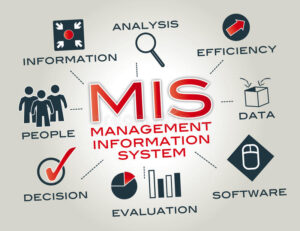
An efficient management information system is required. Therefore, the management executives took the necessary caution while designing the management information system. For creating an efficient management information system, the following conditions must be met.
- The categories of information required by the decision-maker should be determined, defined, and described by top management.
- The structure of the information is also chosen in advance to ensure prompt information delivery.
- Management is able to recognise the issues related to internal information flow. To eliminate the limitations associated with the delivery of poor information, these issues should be resolved.
- The individuals responsible for gathering the information should be informed of and given a clear definition of the information’s sources.
- Management information systems provide alternatives to long-term strategies by taking environmental factors into account.
- The management may choose the ideal MIS design. When choosing the optimum MIS pattern, management should take cost, feasibility, adaptability, and implementability into account.
- Having a high level of creativity and foresight is crucial for designing an efficient management information system. Therefore, while creating MIS, management should use these kind of individuals.
- The MIS should be able to accommodate the organization’s demands, objectives, and environment.
Designing the Management Information System
A series of processes is systematically followed in a management information system to gather relevant data, process the data, and display the data as information in the appropriate manner. when the management is capable of making wise judgments and taking the required steps to operate the firm. The following design principles should be used while developing a system.
- Provides comprehensive, accurate, and timely data: Having access to complete, accurate, and timely data enables effective planning and decision-making. The difficulties associated with inconsistent, lacking, and erroneous data would be resolved by the MIS.
- Identify and quantify interconnected processes: Although production and sales are separate variables, they are closely tied to one another. Production is influenced by product demand, or sales volume. In this way, sales and production information become related. Future trends may be predicted with this.
- Evaluate and manage performance: Production information may be expressed in monetary terms. If so, it will be possible to assess manufacturing costs and govern the performance, which may be carefully observed.
- Determine the demands of a decentralised organisation: In large-scale businesses, departmentalization and power are decentralised. To prevent duplication and effort waste, the requirements of such decentralised divisions and departments may be adequately stated. It implies that a pool is established to gather the information from these divisions and units.
- Information that has been condensed: Information that has been provided such that decisions may be made without additional interpretation or analysis. It cuts down on the amount of time, work, and information required. The senior management at this place adheres to the management by exception approach.
- Flexibility: In order to be modified or amended as needed, the management information system should be as versatile as feasible.
Process of Management Information System
There are six steps involved in the conversion of data into information. Below is a quick explanation of these six steps.
- Assembling: This refers to gathering information and recording it in a number of files. The collecting of data is made easier by the clearly specified sources of information.
- Processing: This refers to the summarization, editing, and processing of the gathered data. The records have been edited to remove the erroneous and irrelevant information.
- Analyzing: This refers to the process of using data analysis to create or compute percentages, ratios, etc. The decision-maker may learn helpful information from percentages and ratios.
- Information storage and retrieval: Information storage includes indexing, coding, filing, and placement. When required, swift relocation and retrieval of this information is possible thanks to the provisions that have been implemented.
- Evaluation: This is the assessment of the correctness, precision, and relevancy of information in determining its usefulness. The level of precision, accuracy, and relevance depends on the decision-requirements. maker’s
- Dissemination: This refers to giving the decision-maker the necessary data in the appropriate format at the appropriate time.
Advantages of Management Information System
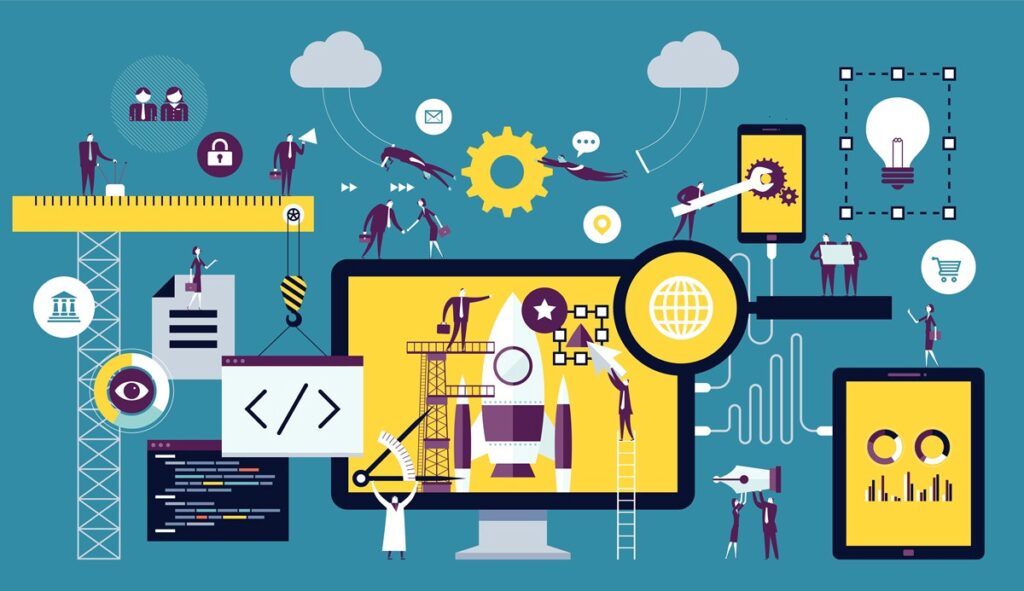
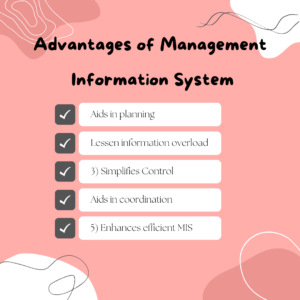
The following are some ways that an efficient management information system benefits management:
1) Aids in planning: Planning needs accurate, timely, and trustworthy information. Under an efficient management information system, they are achievable. The MIS keeps executives informed of developments in the business environment. The planning task performed by the executives is therefore made easier by MIS.
2) Lessen information overload: Managers are not obliged to have access to all of the data that an organisation collects. The data has been separated into relevant and irrelevant categories under effective MIS. Managers may get perplexed by the irrelevant facts. As a result, the unnecessary data has been eliminated thanks to efficient MIS and less information overload.
3) Simplifies Control: Control is made simpler by MIS, which serves as a link between planning and control. It enables managers to make wise decisions, which streamlines the control process.
4) Aids in coordination: MIS is an integrated planning and control methodology. By keeping each department/section informed of the issue, status, significance, and requirements of other departments/sections, MIS enhances coordination. It connects each organization’s decision-making centres.
5) Enhances efficient MIS: Work related to monitoring is also done under control, allowing management to give responsibility without compromising decentralisation.
Causes for Poor Management Information System
A management information system uses computer technology to create an efficient system. Even yet, there can be several reasons why the management information system is inadequate. Here are several examples:
- More information is better: Only with more knowledge can decisions be made that are effective or sound. This is untrue. However, the truth is that for making an informed choice, only information that is pertinent, accurate, and exact is required. More data often overwhelms the decision-maker and possibly causes misunderstanding. The decision-maker could end up somewhere they didn’t intend to go. Furthermore, he won’t be able to take in all the information. Thus, just having correct and relevant information is sufficient.
- Lack of managerial support: Top management support is necessary for effective MIS. Additionally, the decision-maker has to be motivated for MIS to be used effectively. If not, it is useless to continue with MIS.
- Poor communication: Current, relevant information must be sent to the management. The managers should then get training to understand the fundamental functions and nature of computers. A system that allows for greater communication among all decision-makers must be created by a computer professional. However, in reality, computers are employed to create data, which leads to poor communication.
- Computers are limited in what they can accomplish: They can analyse data and present information in a certain way. However, it does not make up for management discretion. Additionally, a computer might be a tool, not a decision-making process.
- Human acceptability: The acceptance and participation of the personnel of the concerned organisation are essential to the MIS’s success. Employee opposition to MIS is common since the system may increase workload or diminish the value of people.
Guidelines for Improving Management Information System
The following recommendations may be used to enhance the management information system.
- Top management must be involved in the MIS design process. Employees of an organisation are more accepting as a result of this participation.
- The MIS designer and user must have a tight working connection. This is produced by encouraging staff members to develop the MIS themselves. Employees are aware of how a company really operates. Employees may thus successfully develop the MIS.
- A master plan might be created. The master plan takes into account both the organization’s present and future demands. The uncertainties associated with MIS development are avoided by the master plan.
- On the basis of a cost-benefit analysis, both designees and users are held accountable for the effectiveness of the MIS. It is not possible to alter responsibility such that benefits outweigh drawbacks.
- Management should make every effort to instil trust in workers’ abilities to see it as a help rather than a substitute.
FREQUENTLY ASKED QUESTIONS
What is a Management Information System (MIS)?
An MIS refers to systems and processes that collect, manage, and distribute information to support decision-making, coordination, and control in an organization. It includes software tools that help organizations gather, process, store, and report data for management purposes, aiding in areas such as customer service, sales, and operations.
Why is MIS important in business?
MIS is critical for improving decision-making, increasing operational efficiency, and helping businesses become more data-driven. By providing managers with accurate, up-to-date information, MIS helps companies improve strategic planning, optimize workflows, and gain competitive advantages.
How does MIS support decision-making?
MIS supports decision-making by providing managers with timely and relevant information through data collection, analysis, and reporting. It uses tools like dashboards, analytics, and simulation models to help forecast trends and make informed decisions.
What are the key components of an MIS?
The key components of an MIS include technology (hardware and software), people (users such as managers and employees), data (the raw information), and processes (procedures to collect, analyze, and distribute data).
What careers are related to MIS?
Careers in MIS include roles such as systems analysts, IT managers, network administrators, business analysts, and information systems managers. These professionals are responsible for developing and managing information systems to ensure efficient business operations.
What are the challenges of implementing an MIS?
Common challenges include aligning the MIS with business needs, ensuring data quality, managing the cost of implementation, and training employees on how to effectively use the system.
